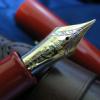Search the Community
Showing results for tags 'cocobolo'.
-
http://i.imgur.com/R9qfTpB.jpg *I apologize for the poor quality iPhone photos taken in my poorly-lit apartment -- I'll borrow a dSLR to get some decent ones before I do a full review. After 13 months my Hakase is finally here! Since I ordered it last December, I've been anxiously awaiting this li...
-
Hakase Cocobolo Flat-top The Hakase Cocobolo resting in its paulownia box. The calligraphy on the box is done by the mother of the current owner of Hakase, Ryo Yamamoto. Yamamoto-san is the grandson of the original founder of Hakase. Introduction As a lover and user of Japanese pens, owning a...


